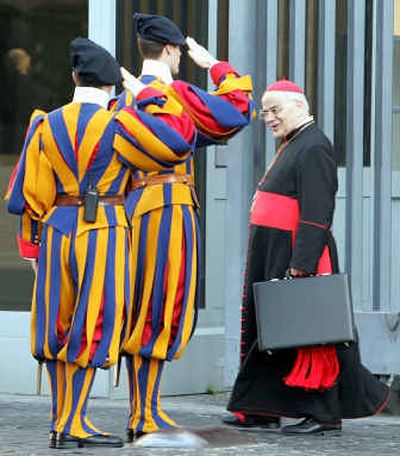Intriguing conclave has sordid past

The stately nobility of the election about to unfold at the Vatican – eagerly watched by world leaders and members of other faiths – is all the more amazing because of the centuries of corruption, greed and murder in its past.
This first papal election of the new millennium is the crowning glory in a papal history that survived enough bizarre twists to fill a dozen sequels to Dan Brown’s “The Da Vinci Code.”
“In some past elections, people behaved very badly,” the Rev. John O’Malley, a noted Catholic historian, said last week from his office at the Weston Jesuit School of Theology in Massachusetts. “Right up through John Paul II, popes have been trying to tie up the loose ends of the process.”
One of the most bizarre loose ends was the “cadaver synod” after the election in 896 of the insanely vengeful Pope Stephen VI. He harbored so much anger at a predecessor, Pope Formosus, that he had his corpse exhumed.
Formosus’ decomposing body was dressed in papal vestments, propped in a throne and put on trial for crimes against church law, including perjury. Unable to mount a defense, Formosus’ ghastly remains were convicted. As punishment, the three fingers Formosus once used to bless the faithful were hacked from his right hand. His body was dragged away and thrown into the Tiber River.
Piling crime upon crime like a modern suspense novel, Stephen soon was thrown into prison himself. Formosus’ friends crept into his cell and strangled him.
“Even professional historians shy away from this period because these things are so horrifying,” said John-Peter Pham, a papal historian at James Madison University in Virginia and the author of the newly released “Heirs of the Fisherman.”
Just how horrible did it get? Well, squeamish readers should skip the next three paragraphs.
Because the papacy often was treated as a political pawn, popes sometimes found themselves at the mercy of ruthless rulers.
Consider poor John XVI, who thought he was the rightful pope, according to Roman nobles who pushed him onto the papal throne in 997. Unfortunately, another politically powerful pope, Gregory V, was alive elsewhere in Europe.
Gregory returned to Rome with an army and wasn’t amused at finding a rival. He ordered John’s eyes put out as well as his nose and ears sliced off. Then, to underline the point, John was excommunicated. Should he wish to object, his lips, teeth and tongue were removed next. And his mutilated body, still alive, was shipped to a monastery.
Check the official list of popes in the Vatican’s “Annuario Pontificio,” the official Vatican fact book, and there are suspicious brackets around John XVI’s name. That’s a sign that he’s now among several dozen men ignominiously dubbed anti-popes. This special class is reserved for the tragic losers in the often-bloody battles for church power.
These feuds explain another curious detail that will crop up when the upcoming conclave ends. At that point, cardinals will declare someone the 265th pontiff, but they’ll also note that he’s the 262nd successor to St. Peter, regarded by Catholics as the first pope.
That glitch is due to the unbridled corruption in Rome in the 11th century, which placed one particularly well-connected Roman layman on the throne three times. He took the name Benedict IX, and the Vatican list credits him with three pontificates, leaving a perennially puzzling math problem for Catholic students.
Evil influences rose and fell with the fortunes of Europe’s powerful clans. A crescendo of corruption came in the 1492-1503 reign of Alexander VI, part of the notorious Borgia family.
Alexander ruled like a secular prince, fathering too many illegitimate children for historians to count. He formed a brutal partnership with his most famous son, Cesare Borgia, to murder their way across central Italy and build up the papal coffers. Cesare is famous as the purported model for Niccolo Machiavelli’s cynical political essay “The Prince.”
Political corruption wasn’t quashed until the early 20th century, O’Malley said. “Before a conclave, leaders in some countries would instruct their cardinals that, if they saw the election was going a certain way, they were to put in a veto of that candidate.”
Emperor Franz Joseph of Austria slipped the last veto into a conclave in 1903, against an Italian he didn’t like. Pope Pius X was elected instead. Even though he benefited from the veto, Pius X barred vetoes in the future, part of a long series of election reforms that continued through John Paul II.
The biggest change 20th century popes made was expanding and diversifying the College of Cardinals. As people around the world watch 115 men from dozens of countries enter the conclave on Monday, the scene will be vastly different from papal transitions even a century ago.
That’s why one of the often-overlooked customs of the conclave – the cardinals’ opening pledge to obey the rules set by the previous pope – is one of the most crucial traditions that will unfold this week.